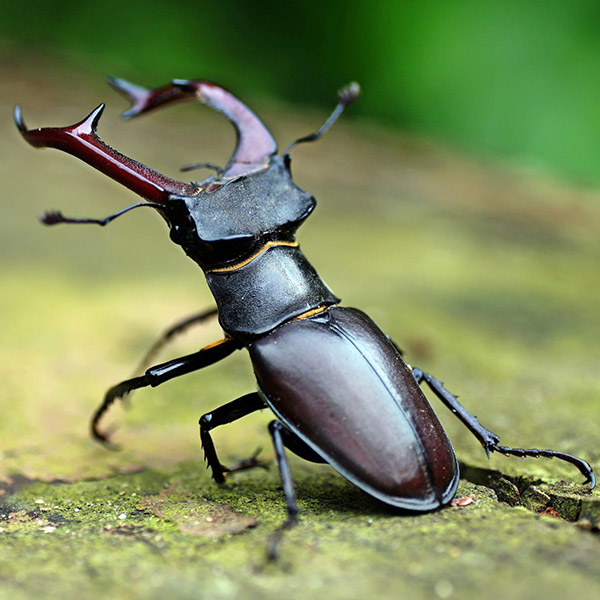Did you know that today is World Wildlife Day? This year’s theme is ‘recovering key species for ecosystem restoration and to celebrate this, we wanted to share with you the importance and conservation of the European stag beetle. You may not realise what an important role this insect has in recycling and ecosystem restoration.
The European stag beetle Lucanus cervus is Britain’s largest beetle, adult males can grow up to 8cm in length and with their spectacular antler-like jaws are easily recognisable. Despite their appearance, stag beetles are harmless, only using their jaws to attract females and duel with their mating rivals in the breeding season.
Stag beetles are completely reliant on dead wood and are a part of the recycling process, bringing nutrients back into the soil, making them a very important part of the ecosystem. They are prominently found in Britain’s gardens, parks, woodlands, farmlands, and traditional orchards and although once widespread throughout Europe, have undergone a significant, rapid decline, leading to extinction in Denmark and Latvia, and are now Red listed in many European countries.
The main reason for the species’ decline is the loss of its key habitat. The tidying-up of woodland, parks, and gardens and the changing of broad-leaved woodland into farmland, forestry plantations and urban development removes the deadwood habitats that the stag beetle larvae rely upon for food. Tree surgery operations such as stump-grinding of felled trees also remove a vital habitat for the stag beetle.
Due to urbanisation and their love for the warm surfaces of tarmac and pavements, stag beetles are vulnerable to traffic or being trodden on and some are killed deliberately because they are seen as dangerous or mistaken for pests.
As well as this, they are a food source to birds, cats, and foxes. Although this is mostly natural predation, the increase in magpie and carrion crow populations in the last decade may also be having a detrimental impact on stag beetle populations.
Because of their decline in numbers, stag beetles are now legally protected from sale in the UK and classed as a priority species for conservation under Schedule 5 of the Wildlife and Countryside Act 1981. They are also regarded as a priority species under the UK Post-2010 Biodiversity Framework and listed as a species on many county/districts’ Biodiversity Action Plans.
If found to be present on a site where they will be affected, our ecologists will be able to advise on a suitable mitigation strategy, including translocation of deadwood and/or creation of log piles.
Anyone with a garden can help boost stag beetle populations by creating log piles or leaving deadwood to rot down in a shaded part of the garden, as well as reburying beetle larvae if dug up accidentally. Avoid using mulch or polythene as newly emerging stag beetles can become trapped and die, cover water butts and add an escape route to ponds such as a well-placed pile of stones or a log.
In new developments, it is recommended that stag beetle ‘loggeries’ or ‘insect hotels’ are created within the wildlife areas, that are relatively undisturbed, and linked to surrounding suitable habitat.

